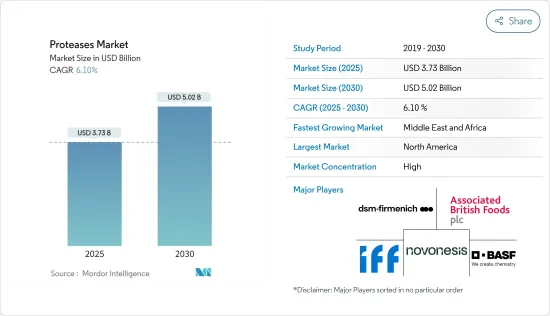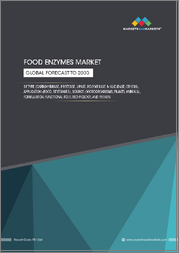
|
시장보고서
상품코드
1686202
프로테아제 시장 : 시장 점유율 분석, 산업 동향 및 통계, 성장 예측(2025-2030년)Proteases - Market Share Analysis, Industry Trends & Statistics, Growth Forecasts (2025 - 2030) |
||||||
프로테아제 시장 규모는 2025년에 37억 3,000만 달러로 추계되고, 2030년에는 50억 2,000만 달러에 달할 것으로 예측되며, 예측 기간(2025-2030년) CAGR은 6.1%를 나타낼 전망입니다.

세계의 가공식품산업은 RTC 및 RTE 제품을 요구하는 소비자의 라이프스타일의 변화에 의해 현저한 성장을 이루고 있습니다. 이는 예측 기간 동안 프로테아제에 대한 수요를 견인할 것으로 예상됩니다. 또한 미생물 프로테아제는 대사 활동에서 중요한 역할과 산업에서의 막대한 활용으로 인해 관심을 받고 있습니다. 미생물 유래 프로테아제는 더 높은 수율, 낮은 시간 소비 및 비용 효율성을 제공하여 시장에서 생명 공학 응용 분야에 적합하게 만들었습니다.
프로테아제는 프로테아제, 펩티다제 및 아미다제 역할을 하는 다양한 효소 그룹으로 특히 식품, 세제 및 제약 산업에서 광범위한 산업 응용 분야를 가지고 있습니다. 프로테아제는 단백질의 펩타이드 결합을 분해하는 필수 산업 효소이며 화학 및 생물학적 공정에서 다양한 용도로 사용됩니다. 프로테아제 사용의 주요 장점 중 하나는 천연 제품을 생산하고 온화한 반응 조건에서 활성을 나타내며 입체 특이성, 특이성 및 생분해성을 나타낸다는 점입니다. 기업들은 반응 시간을 단축하여 전체 수율을 향상시키는 혁신적인 제품을 출시했습니다. 프로테아제는 빠르게 변화하는 많은 일용소비재(FMCG) 제품을 개발하는 데 매우 중요한 역할을 합니다. 시장의 주요 동인은 다양한 산업 분야에서 프로테아제가 다양하게 활용되고 있다는 점입니다. 또한 무독성 및 비병원성 특성으로 인해 친환경적이라는 점도 시장을 더욱 활성화하고 있습니다.
프로테아제는 동물 사료 산업에서 사료의 영양 성분과 소화율을 개선하여 동물의 성장과 전반적인 건강을 증진하는 데 사용됩니다. 프로테아제는 돼지, 가금류, 양식 어종과 같은 동물의 소화관에서 복잡한 단백질을 더 간단한 펩타이드와 아미노산으로 분해하여 더 쉽게 흡수할 수 있도록 돕습니다. 이러한 효소 작용은 영양소 이용의 효율성을 개선할 뿐만 아니라 흡수와 소화를 방해할 수 있는 항영양 성분을 감소시킵니다. 또한 프로테아제는 고단백 사료 원료의 필요성을 줄여줌으로써 사료 비용을 절감하고 질소 배설을 줄여 동물 생산에 따른 환경 영향을 줄일 수 있습니다. 독일 축산업협회(Bundesanstalt fur Landwirtschaft und Ernahrung)에 따르면, 2023년 독일 전역에서 약 153만 톤의 가금류가 생산될 것으로 예상됩니다. 축산업의 확장과 동물 사료에 대한 수요 증가는 전 세계적으로 프로테아제 시장에 충분한 기회를 제공합니다.
프로테아제 시장 동향
식음료 산업에서 프로테아제 적용 증가로 시장 성장 견인
식품 산업에서 프로테아제는 다양한 식품의 질감, 풍미 및 영양가를 향상시키는 데 널리 사용됩니다. 파파인과 브로멜라인과 같은 프로테아제는 육류 가공 과정에서 근육 섬유를 분해하여 질긴 부위를 부드럽게 하고 육즙이 많은 고기를 생산합니다. 전 세계 여러 지역에서 육류 소비가 증가함에 따라 육류 및 가금류 산업에서 프로테아제 수요가 성장할 수 있는 충분한 기회가 있습니다. 미국 농업경제연구청에 따르면 2022년 육계, 소고기, 돼지고기의 1인당 소비량은 각각 98.9파운드, 59.1파운드, 51.1파운드였습니다.
유제품 생산에서 레닛에 포함된 키모신은 치즈 제조에 필수적이며, 우유 응고 및 커드 형성을 촉진하고 숙성 과정에서 치즈의 풍미를 향상시킵니다.프로테아제는 글루텐의 구조를 변화시켜 비스킷이나 크래커와 같은 제빵 제품의 중요한 특성인 반죽의 탄력과 일관성을 향상시키기 때문에 제빵 산업에서도 활용되고 있습니다. 프로테아제는 맥주 양조 시 헤이즈를 유발하는 단백질을 제거하여 맥주의 안정성과 투명도를 보장합니다. 마찬가지로 이 효소는 주스 생산에도 필요하며, 단백질로 인한 탁도를 제거하여 맑은 음료를 생산합니다. 따라서 프로테아제는 식음료 산업 전반에 걸쳐 널리 사용되고 있습니다.
시장에서 활동하는 기업들은 혁신을 거듭하며 신제품을 개발하고 있습니다. 그들은 또한 증가하는 수요를 충족시키기 위해 새로운 프로테아제를 테스트하고 개발하기 위해 다른 전략을 사용하고 있습니다. 예를 들어, 2022년 9월, Creative Enzymes는 효모 외인성 단백질 발현에서 분비된 펩타이드를 절단하기 위해 재조합된 사카로미세스 세레비지애의 Kex2 프로테아제를 출시했습니다. 프로테아제 효소는 식음료 산업에서 다양하게 활용되고 있습니다. 폐기물 생산 감소, 처리 효율성 향상, 천연 자원 보존에 중요한 역할을 하기 때문에 향후 몇 년 동안 시장이 크게 성장할 것으로 예상됩니다.
북미가 프로테아제 시장을 독점
북미는 신약 개발, 단백질 공학 및 치료 용도로 프로테아제를 사용하는 첨단 생명공학 및 제약 산업의 중심지입니다. 예를 들어, 2023년 3월 IFF의 사업부인 Danisco Animal Nutrition &Health는 자돈 생산의 주요 과제를 해결하기 위해 설계된 최적화된 효소 혼합물인 Axtra PRIME(자일라나제, β-글루카나제, α-아밀라아제, 프로테아제 효소의 조합)를 출시했습니다. 프로테아제는 북미의 대규모의 정교한 식음료 산업에서 다양한 용도로 광범위하게 사용되고 있습니다. . 예를 들어, 프로테아제는 양조 공정, 치즈 생산, 육류 연화 등에 활용됩니다. 프로테아제는 안호이저-부시 인베브와 크래프트 하인즈 같은 기업에서 제품 품질과 가공 효율성을 개선하기 위해 사용합니다.
특히 식품 및 제약 분야에서 프로테아제 기반 제품의 개발과 상용화는 미국 식품의약국(FDA)이 제공하는 규제 환경의 지원을 받고 있습니다. 이러한 규제 지원으로 프로테아제의 효능과 안전성이 보장되어 시장 수용성이 높아졌습니다. 기능성 식품 및 건강 보조제에 대한 수요 증가로 인해 제품에서 프로테아제 사용량이 증가하고 있습니다. 북미에서는 소비자들이 프로테아제의 건강상의 이점에 대한 인식이 높아짐에 따라 건강기능식품에 대한 수요가 증가하고 있습니다. 미국 국립의학도서관에 따르면 프로테아제는 심혈관 질환 치료에 주로 사용되어 왔지만 패혈증, 소화 장애, 염증, 낭포성 섬유증, 망막 장애, 건선 및 기타 질병 치료에도 유용한 약제로 부상하고 있습니다.
따라서 북미의 프로테아제 시장 리더십은 강력한 산업 수요, 혁신적인 기술 개발, 우호적인 규제 프레임워크, 상당한 R&D 지출, 다양한 산업에서의 광범위한 응용 분야에 의해 촉진되고 있습니다. 이러한 모든 요소가 함께 작용하여 지역 시장의 선도적 지위와 꾸준한 확장을 뒷받침하고 있습니다.
프로테아제 산업 개요
프로테아제 시장은 자연적으로 통합되어 있으며 상위 업체가 주요 시장 점유율을 차지하고 있습니다. 이 시장의 주요 기업으로는 International Flavors &Fragrances Inc., DSM-Firmenich AG, Novonesis Group, BASF SA, Associated British Foods PLC 등이 있습니다. 이 업체들은 시장에서 선도적인 위치를 유지하고 강력한 브랜드 이미지를 구축하기 위해 다양한 전략을 채택하고 있습니다. 이러한 업체들이 채택하는 주요 전략에는 인수 합병이 포함되며, 이를 통해 시장 지위를 공고히 하고 제품 포트폴리오를 확장할 수 있습니다.
제품 혁신과 신제품 개발은 소비자의 수요와 선호도를 충족시키기 위해 상위 업체들이 채택하는 필수 전략입니다. 기업들은 새롭고 개선된 제품을 출시하기 위해 연구 개발 활동에 많은 투자를 하며, 이를 통해 경쟁사와 제품을 차별화하고 고객층을 확대할 수 있습니다. 또한 기업은 새로운 제품 라인을 추가하고 새로운 비즈니스를 인수하여 제품 포트폴리오를 확장하는 데 주력합니다. 이러한 전략을 통해 기업은 소비자의 변화하는 니즈와 선호도를 충족하고 시장 점유율을 높일 수 있습니다.
기타 혜택
- 엑셀 형식 시장 예측(ME) 시트
- 3개월간의 애널리스트 지원
목차
제1장 서론
- 조사의 전제조건과 시장 정의
- 조사 범위
제2장 조사 방법
제3장 주요 요약
제4장 시장 역학
- 시장 성장 촉진요인
- 효소 공학 및 바이오 프로세싱의 기술 발전
- 전문적이고 지속 가능한 재료에 대한 성향 증가
- 시장 성장 억제요인
- 높은 생산 비용으로 시장 성장 저해
- Porter's Five Forces 분석
- 신규 참가업체의 위협
- 구매자, 소비자의 협상력
- 공급기업의 협상력
- 대체품의 위협
- 경쟁 기업간 경쟁 관계의 강도
제5장 시장 세분화
- 유래
- 동물
- 트립신
- 펩신
- 레닌
- 기타 동물 유래
- 식물
- 파파인
- 브로멜라인
- 기타 식물 유래(케라티나제 및 피신)
- 미생물 유래
- 알칼리 프로테아제
- 산성 프로테아제
- 중성 프로테아제
- 동물
- 용도
- 음식
- 유제품
- 베이커리
- 음료
- 육류 및 가금류
- 유아용 조제 분유
- 의약품
- 동물 사료
- 기타 용도
- 음식
- 지역
- 북미
- 미국
- 캐나다
- 멕시코
- 기타 북미
- 유럽
- 스페인
- 영국
- 프랑스
- 독일
- 이탈리아
- 기타 유럽
- 아시아태평양
- 중국
- 일본
- 인도
- 싱가포르
- 호주
- 기타 아시아태평양
- 남미
- 브라질
- 아르헨티나
- 기타 남미
- 중동 및 아프리카
- 남아프리카
- 아랍에미리트(UAE)
- 사우디아라비아
- 기타 중동 및 아프리카
- 북미
제6장 경쟁 구도
- 주요 기업의 전략
- 시장 점유율 분석
- 기업 프로파일
- Novus International Inc.
- International Flavors & Fragrances Inc.
- DSM-Firmenich AG
- Biocatalyst Ltd
- Novonesis Group
- Advanced Enzyme Technologies
- Associated British Foods PLC
- Bioseutica BV
- BASF SE
- Kemin Industries Inc.
제7장 시장 기회와 앞으로의 동향
HBR 25.04.04The Proteases Market size is estimated at USD 3.73 billion in 2025, and is expected to reach USD 5.02 billion by 2030, at a CAGR of 6.1% during the forecast period (2025-2030).

The global processed food industry is experiencing significant growth, driven by changing consumer lifestyles that demand ready-to-cook/eat products. This is expected to drive the demand for proteases during the forecast period. Additionally, microbial proteases have gained interest due to their vital role in metabolic activities and their immense utilization in industries. The proteases available in the market that are of microbial origin offer higher yield, lower time consumption, and cost-effectiveness, which have made them suitable for biotechnological applications in the market.
Proteases are a diverse group of enzymes that act as proteinases, peptidases, and amidases and have a broad range of industrial applications, particularly in the food, detergent, and pharmaceutical industries. Proteases are essential industrial enzymes that break down peptide bonds in proteins and find numerous uses in chemical and biological processes. One of the main advantages of using proteases is their ability to produce natural products, exhibit activity under mild reaction conditions, and exhibit stereospecificity, specificity, and biodegradability. Companies have introduced innovative products that reduce reaction time to enhance overall yield. Proteases are crucial in developing many fast-moving consumer good (FMCG) products. The market's primary driver is the multiple applications of proteases in various industries. Additionally, their non-toxic and non-pathogenic attributes make them eco-friendly, further boosting the market.
Proteases are used in the animal feed industry to improve the nutritional content and digestibility of feed, which promotes better animal growth and general health. Proteases facilitate the easier absorption of complex proteins in the digestive tracts of animals like pigs, poultry, and aquaculture species by breaking them down into simpler peptides and amino acids. In addition to improving the effectiveness of nutrient utilization, this enzymatic action also lessens the anti-nutritional elements that may impede absorption and digestion. Furthermore, by reducing the need for high-protein feed ingredients, proteases can reduce feed costs and the environmental impact of animal production by reducing nitrogen excretion. According to the Bundesanstalt fur Landwirtschaft und Ernahrung, approximately 1.53 million tons of dressed-weight poultry were produced across Germany in 2023. The expansion of the animal husbandry industry and rising demand for animal feed offer ample opportunities for the protease market worldwide.
Proteases Market Trends
Rising Application of Proteases in the Food & Beverage Industry Driving Market Growth
In the food industry, proteases are widely used to enhance various food products' texture, flavor, and nutritional value. Proteases such as papain and bromelain break down muscle fibers to tenderize tough cuts and produce more succulent meat during meat processing. The high consumption of meat across various regions worldwide offers ample opportunities for the growth of protease demand in the meat and poultry industry. According to the US Department of Agriculture and Economic Research Service, in 2022, the per capita consumption of broilers, beef, and pork was 98.9 pounds, 59.1 pounds, and 51.1 pounds, respectively.
Enzymes like chymosin found in rennet are essential for the production of cheese and dairy products as they aid in the coagulation of milk and the formation of curds, as well as enhancing the flavor of the cheese as it ages. Proteases have applications in the baking industry since they alter the structures of gluten, enhancing the dough's elasticity and consistency, which are important qualities for baked goods like biscuits and crackers. Proteases remove proteins that cause haze in beer brewing, guaranteeing its stability and clarity. Similarly, these enzymes are necessary for the production of juice, which removes turbidity caused by proteins to produce clear drinks. Hence, proteases are widely used across the food and beverage industry.
Companies operating in the market have been innovating and developing new products. They are also using other strategies to test and develop new proteases to cater to the rising demand for the same. For instance, in September 2022, Creative Enzymes launched Kex2 Protease from Saccharomyces cerevisiae, Recombinant, for the cleavage of secreted peptides in yeast exogenous protein expression. Protease enzymes have diverse applications in the food and beverage industries. The market is expected to grow significantly in the upcoming years due to its vital role in reducing waste production, improving processing efficiency, and preserving natural resources.
North America Dominates the Proteases Market
North America is host to advanced biotechnology and pharmaceutical industries that use proteases for drug development, protein engineering, and therapeutic uses. For instance, in March 2023, Danisco Animal Nutrition & Health, a business unit of IFF, launched Axtra PRIME (a combination of xylanase, beta-glucanase, alpha-amylase, and protease enzymes), an optimized enzyme blend designed to address key challenges in piglet production. Proteases are used extensively in a variety of applications by the large and sophisticated food and beverage industry in North America. Proteases are utilized, for instance, in the brewing process, cheese production, and meat tenderization. Proteases are used by businesses like Anheuser-Busch InBev and Kraft Heinz to improve product quality and processing effectiveness.
The development and commercialization of protease-based products, particularly in food and pharmaceuticals, are supported by the regulatory environment provided by the US Food and Drug Administration (FDA). Protease efficacy and safety are guaranteed by this regulatory support, which increases market acceptance. Protease usage has increased in products due to the growing demand for functional foods and health supplements. There is a growing demand for nutraceuticals in North America as consumers become more conscious of the health benefits of proteases. According to the National Library of Medicine, while the predominant use of proteases has been in treating cardiovascular disease, they are also emerging as useful agents in the treatment of sepsis, digestive disorders, inflammation, cystic fibrosis, retinal disorders, psoriasis, and other diseases.
Hence, the protease market leadership of North America is fueled by strong industrial demand, innovative technology developments, a benevolent regulatory framework, significant R&D expenditure, and a wide range of applications in various industries. All these elements work together to support the regional market's leading position and steady expansion.
Proteases Industry Overview
The protease market is consolidated in nature, with the top players occupying major market shares. Some of the major players in this market include International Flavors & Fragrances Inc., DSM-Firmenich AG, Novonesis Group, BASF SA, and Associated British Foods PLC. These players adopt various strategies to maintain their leading position in the market and build a strong brand image. The key strategies these players adopt include mergers and acquisitions, which help them consolidate their market position and expand their product portfolios.
Product innovation and new product development are essential strategies adopted by top players to cater to consumer demand and preferences. Companies invest heavily in research and development activities to introduce new and improved products, which help them differentiate their products from their competitors and expand their customer base. Moreover, companies also focus on expanding their product portfolios by adding new product lines and acquiring new businesses. This strategy enables companies to cater to consumers' evolving needs and preferences and increase their market share.
Additional Benefits:
- The market estimate (ME) sheet in Excel format
- 3 months of analyst support
TABLE OF CONTENTS
1 INTRODUCTION
- 1.1 Study Assumptions and Market Definition
- 1.2 Scope of the Study
2 RESEARCH METHODOLOGY
3 EXECUTIVE SUMMARY
4 MARKET DYNAMICS
- 4.1 Market Drivers
- 4.1.1 Technological Advancements in Enzyme Engineering & Bioprocessing
- 4.1.2 Growing Inclination Toward Specialty and Sustainable Ingredients
- 4.2 Market Restraints
- 4.2.1 High Production Costs Impede Market Growth
- 4.3 Porter's Five Forces Analysis
- 4.3.1 Threat of New Entrants
- 4.3.2 Bargaining Power of Buyers/Consumers
- 4.3.3 Bargaining Power of Suppliers
- 4.3.4 Threat of Substitute Products
- 4.3.5 Intensity of Competitive Rivalry
5 MARKET SEGMENTATION
- 5.1 Source
- 5.1.1 Animal
- 5.1.1.1 Trypsin
- 5.1.1.2 Pepsin
- 5.1.1.3 Renin
- 5.1.1.4 Other Animal Sources
- 5.1.2 Plant
- 5.1.2.1 Papain
- 5.1.2.2 Bromelain
- 5.1.2.3 Other Plant Sources (Keratinases and Ficin)
- 5.1.3 Microbial
- 5.1.3.1 Alkaline Protease
- 5.1.3.2 Acid Protease
- 5.1.3.3 Neutral Protease
- 5.1.1 Animal
- 5.2 Application
- 5.2.1 Food and Beverage
- 5.2.1.1 Dairy
- 5.2.1.2 Bakery
- 5.2.1.3 Beverages
- 5.2.1.4 Meat and Poultry
- 5.2.1.5 Infant Formula
- 5.2.2 Pharmaceuticals
- 5.2.3 Animal Feed
- 5.2.4 Other Applications
- 5.2.1 Food and Beverage
- 5.3 Geography
- 5.3.1 North America
- 5.3.1.1 United States
- 5.3.1.2 Canada
- 5.3.1.3 Mexico
- 5.3.1.4 Rest of North America
- 5.3.2 Europe
- 5.3.2.1 Spain
- 5.3.2.2 United Kingdom
- 5.3.2.3 France
- 5.3.2.4 Germany
- 5.3.2.5 Italy
- 5.3.2.6 Rest of Europe
- 5.3.3 Asia-Pacific
- 5.3.3.1 China
- 5.3.3.2 Japan
- 5.3.3.3 India
- 5.3.3.4 Singapore
- 5.3.3.5 Australia
- 5.3.3.6 Rest of Asia-Pacific
- 5.3.4 South America
- 5.3.4.1 Brazil
- 5.3.4.2 Argentina
- 5.3.4.3 Rest of South America
- 5.3.5 Middle East and Africa
- 5.3.5.1 South Africa
- 5.3.5.2 United Arab Emirates
- 5.3.5.3 Saudi Arabia
- 5.3.5.4 Rest of Middle East and Africa
- 5.3.1 North America
6 COMPETITIVE LANDSCAPE
- 6.1 Strategies Adopted by Leading Players
- 6.2 Market Share Analysis
- 6.3 Company Profiles
- 6.3.1 Novus International Inc.
- 6.3.2 International Flavors & Fragrances Inc.
- 6.3.3 DSM-Firmenich AG
- 6.3.4 Biocatalyst Ltd
- 6.3.5 Novonesis Group
- 6.3.6 Advanced Enzyme Technologies
- 6.3.7 Associated British Foods PLC
- 6.3.8 Bioseutica BV
- 6.3.9 BASF SE
- 6.3.10 Kemin Industries Inc.



















